![[Movie] Enjoying Traditional Japanese Music and Instruments!](https://rimage.gnst.jp/livejapan.com/public/article/detail/a/00/02/a0002400/img/basic/a0002400_main.jpg?20181129132757&q=80)
When it comes to traditional Japanese music we can all conjure specific sounds, scores, or even theatrical plays. It’s rare, though, to be able to fully understand the wide variety of genres, styles, and forms of execution that shape Japanese traditional music. Here we'll go in deep - explaining some of the context and instrumentation behind Japanese music, and end by introducing where you can enjoy a concert during your Tokyo stay!
Brief History & Genres
One of the first obstacles that one faces is the sheer volume of subgenres that are encompassed by the term “Japanese music”, as well as the hundreds of instruments that are more or less commonly used to play it. Yet, for the Japanese culture enthusiast, understanding the origin of the country’s music, and of the various performances, as well as following it on its evolution to the modern times, can be an interesting and rewarding (albeit demanding) task. Well, we are here today to simplify this task. Even those who may not be interested in Japan in general would often be able to associate Japanese music to its country of origin. The instruments that are used are often country-specific. The sounds produced spell “Asia” and especially “Land of the Rising Sun”. One of the main reasons, although often overlooked, lies in the origin of the music itself.
It’s worth it here to take a little detour down music-history lane. The modern seven-note system was first developed in Italy by the monk Guido d’Arezzo in the 11th century CE. This kind of musical notation then spread across the globe to become the standard one. Obviously the playing of music predates the seven-note musical scale by millennia, and Japanese music is no exception. While traditional music in Japan does use this widespread scale, it often employs other scales, such as the pentatonic (five-tone) scale (very common since the Heian Period (794-1185CE)). Other scales that are not unusual are the dodecaphonic (twelve tone) scale, or variations of the heptatonic (seven tone) scale. In addition to the instruments and the style the artists use, these scales create a unique, distinctive, and often exotic sound.
So we now have the basics down, but how do we define what Japanese traditional music is?
Historically, in Japanese culture, there is virtually no event which is not accompanied by music, and the genres, as well as the instruments that are used, vary depending on the event itself, its roots, and even the region to which it belongs. Such variety derives mostly from the fact that Japanese music draws from real life and from nature. This is in fact a very common practice in Japan where nature plays a determining role in architecture, garden composition, and even the presentation of food. Despite the large number of options out there though, we can divide Japanese traditional music in three main categories: Gagaku (court music), theatrical, and instrumental.
1. Gagaku
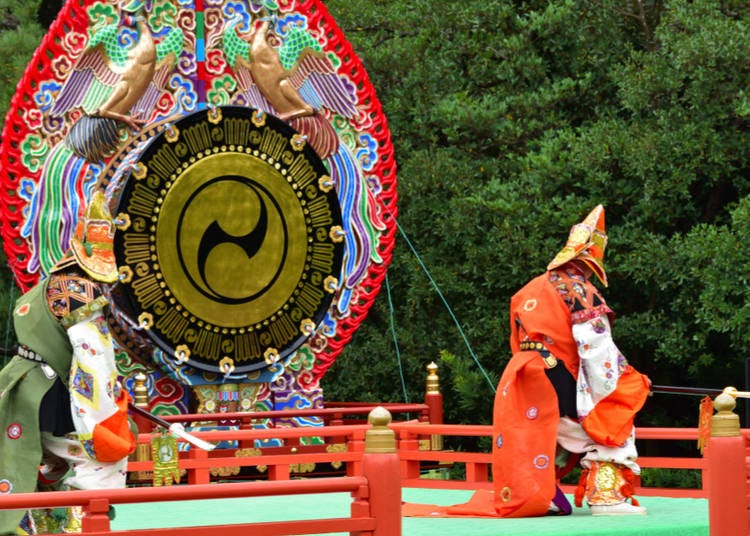
Gagaku is a Japanese form of classical music. It has a rich heritage, and its historical importance carries on to this day. Gagaku is the oldest living orchestra in the world. This music was imported to Japan from China, but it soon separated itself from its Chinese counterpart in style and circumstances in which it was used. In China it was mostly used to entertain, and accompany banquets. The Japanese version of it quickly became music for the elite. Gagaku was performed exclusively by musicians belonging to guilds based in Kyoto, Nara, and Osaka. The right and privilege to play in the orchestra was passed on from father to son, and this music was, for a very long time, performed exclusively in the Kyoto Imperial Palace. The rise of the Kamakura Shogunate (1185-1333CE), and its establishing of a military ruling class, changed things. Gagaku became music for aristocrats, and it lost its luster and popularity. While it had never disappeared, it regained part of its old relevance only during the Meiji Restoration, starting in 1868. That’s when the descendants of the three guilds formed what is currently the Tokyo Imperial Palace Music Department.
Since its inception, the instruments used in Gagaku have been many kinds of wind, percussion, and string pieces. The current composition of 16 to 30 musicians has been established in the 19th century and it presents many of what are probably the most recognizable Japanese typical instruments.

Gagaku woodwind section
Fue
The fue is a category of non-reed flutes made of bamboo. Fue come in many varieties, but especially popular ones are the shinobue (pictured above), which is often found at Japanese festivals, and the shakuhachi, which tends to have fewer keys.
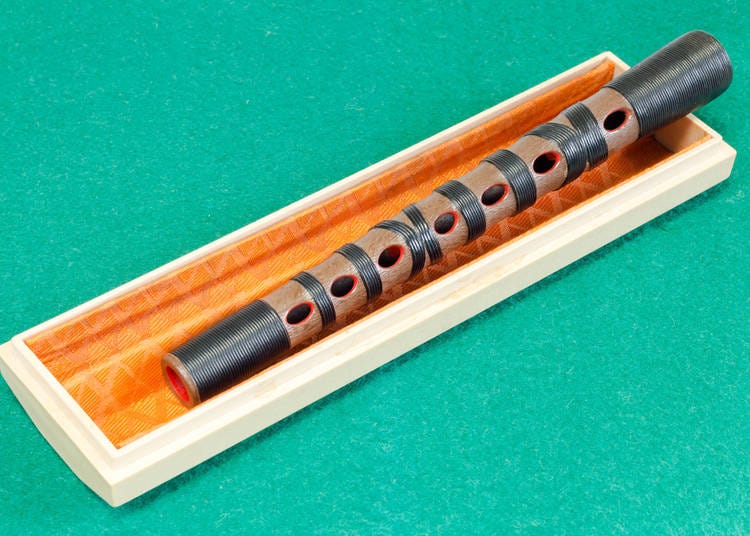
Hichiriki
The hichiriki is a double reed flute. It presents two reeds, which produce the instrument distinctive sound by vibrating against the mouthpiece of the hichiriki. This is the most used instrument in almost every form of Gagaku, and it’s also the instrument of choice of the Japanese composer Hideki Kogi.
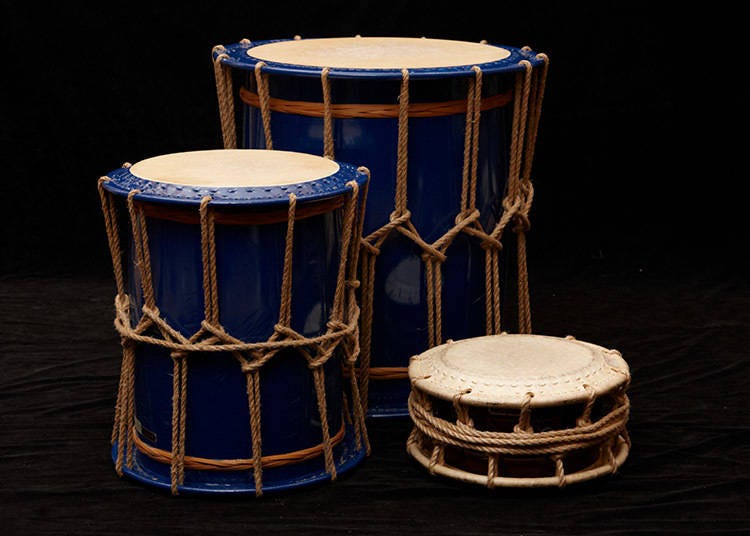
Gagaku percussion section
Taiko
The taiko is possibly the most recognizable Japanese drum, or even instrument. Its origins are unclear, although it may have been influenced by Chinese and Korean percussions. Depending on its purpose, the crafting of this drum varies, and it can take up to several years to finish one piece.
Kakko
The kakko is a smaller drum, usually double headed. It differs from the taiko especially in how its made tout. The skin is first stretched over metal hoops and then attached to the body. The kakko is usually played by laying it on its side.

Chappa
Belonging to a class of small hand percussion instruments known as narimono, the chappa are small hand cymbals and are present in a variety of musical styles, from Buddhist rituals to kabuki music.
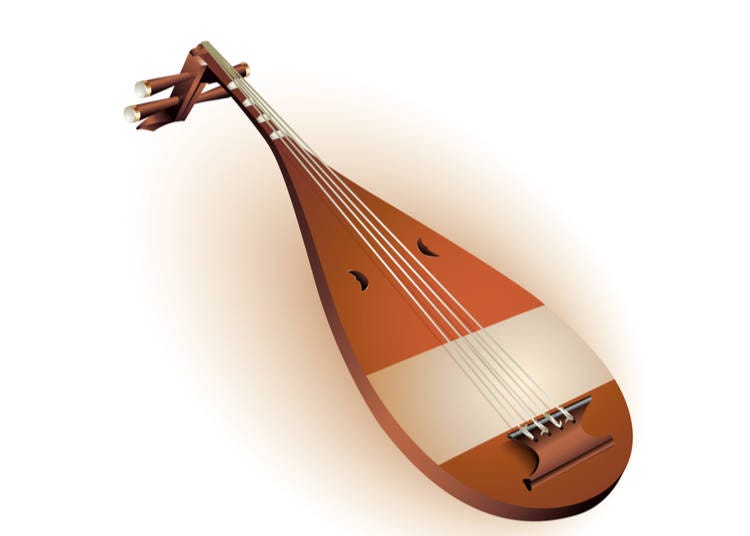
Gagaku string section
Biwa
The biwa is a short necked lute used mostly to accompany narrative storytelling. The one used exclusively in Gagaku is larger than its counterparts. It presents four strings and four frets. It’s played from a seated position and it’s picked with a hard, small, rounded plectrum. This instrument nearly disappeared during the Meiji restoration, but it had a strong comeback after the end of WWII.
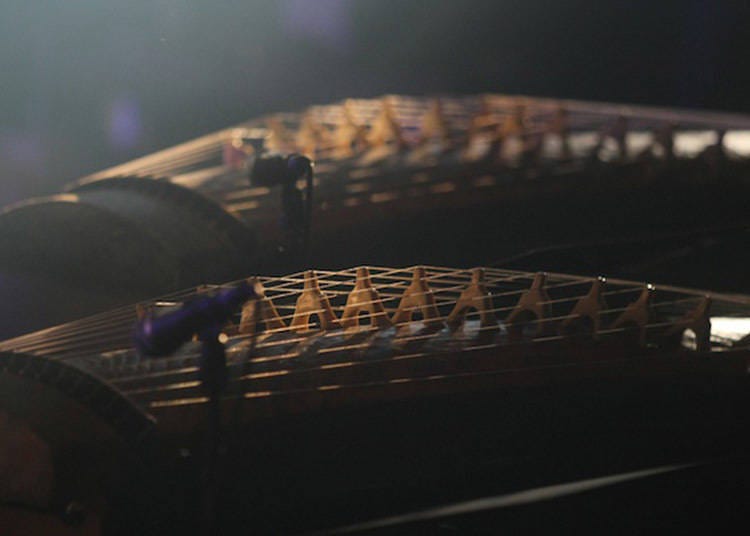
Koto
The koto is a 13–string wood instrument composed of 13 removable bridges. It can also appear in a 17-string variety. The sound is produced by plucking the string with three fingers, and the pitch of the cords can be changed by adjusting the length of the bridges.
In Gagaku the choice of instruments and orchestra composition differs depending on the occasion. Gagaku is the traditional music of religious ceremonies and folk poetry, but it also extended its influence to include the Bugaku, a traditional dance performed for selected elites (in particular the imperial family) since the 9th century CE.
2. Theatrical Music
Approaching the study of theatrical music in Japan can, at times, appear overwhelming. This is mostly because it’s hard to define what theatrical music really is and how it’s used. What kind of stage performances fall into this category? The confusion is understandable as it’s true that essentially any music accompanying any theatrical performance could be called theatrical music, but there are numerous distinctions to consider, and conventionally when we refer to Japanese theatrical music we are talking, for the most part, about Noh or Kabuki, which themselves encompass many different styles.

Noh
The origin of Noh can be traced back to the 8th century when it included various types of performance ranging from acting, to acrobatic shows, to music, and theatre. Noh took the shape for which its known and very respected to this day, in the 14th century. Noh originated in China and it has later been adopted by Japanese artists, becoming a form of art made popular by few families specialized in theatrical and musical performances. Another interesting theory brought forth by Shinhachiro Matsumoto suggests that Noh was heavily employed by former outcasts to regain status with the ruling class.
Noh is the oldest major theatrical art still performed today in Japan. It depicts the life and society of people living between the 12th and the 16th century. A traditional Noh show includes five Nho plays, separated by comedic intermissions called Kyougen.
Considered an extremely complex performance, Noh makes use of masks, makeup, costumes, acting, and music performed by very skilled artists, contributing to the high regard to which it’s hold to this day.
Noh performances are accompanied by musicians called Hayashi. Being Noh a form of chanted drama it’s often compared to western opera, which often approaches similar themes (although in a western setting), despite it being strikingly different in style.
The hayashi ensemble is usually composed of four musicians playing three different percussions and one flute.
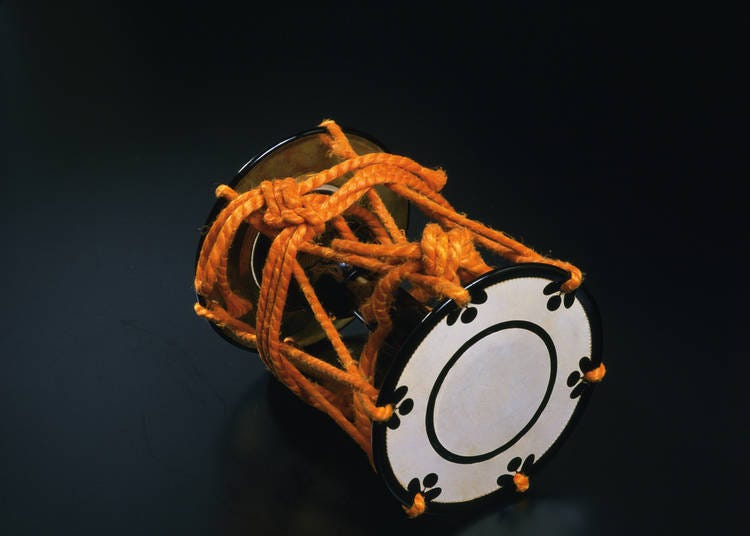
Noh instruments
Percussions
Shime-daiko
These drums are played with sticks (similarly to taiko drums) and are suspended on a stand. The body is short and wide and the same skins are applied at both the top and the bottom of the instrument, and then tied together. This approach, along with metal hoops on which the skins are strung, creates the shime-daiko distinctive sound.
Ootsuzumi
This hourglass shaped drum is probably the most complicated percussion to care for, among the Japanese traditional ones. Unlike many other kinds of percussions, which are supposed to be moist to a certain degree, the Ootsuzumi has to be dry at all times. Horsehide is used to create the drum heads, and, in order to maintain it dry, it’s often stored by a hibachi (furnace). It’s played with bare hands and it’s renowned for being painful to master, requiring the musician to develop very thick calluses.
Tsuzumi
This is a smaller version of the ootsuzumi. It presents the same shape, and, unlike its larger counterpart, it’s designed to allow the musician to change the sound and pitch it produces by tightening or loosening the skin while playing. The tsuzumi is also commonly used in Kabuki, as well as Japanese folk music.
Wind
Nohkan
The nohkan is a kind of transverse flute. Like the tsuzumi it is also often used in Kabuki theatre. It’s built with strips of smoked bamboo to preserve its integrity, and the hard shell of the material is placed to face the core of the flute for improved acoustics. Unlike many other similar instruments, the nohkan produces a characteristic high-pitch sound.
3. Kabuki theatre
Very popular and known worldwide, Kabuki is probably the best-known form of Japanese theatre. Kabuki is a “UNESCO Intangible Cultural Heritage of Humanity”, but its journey to get to this point saw it undergo numerous struggles and changes.
Kabuki today is knows to be, for the most part, an all-male cast type of theatre, but at its inception it was quite the opposite. Kabuki first appeared in 1603 when Izumo no Okuni began performing a new style of dance drama in Kyoto.
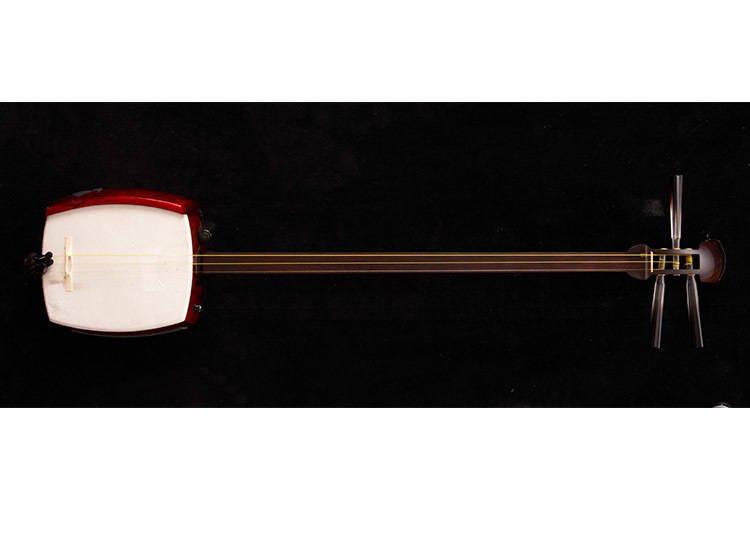
This kind of performance became wildly popular making its way to the imperial court. The actors were all women. Kabuki, though, was not meant exclusively for elite audiences and it was often enjoyed by people of all classes. Because of this reason, the Shogunate never fully accepted it, seeing this mixing of classes as unnatural. Women were banned from performing and that’s how the all-male kabuki was born. The following two centuries, until the mid 1800’s were the golden era of Kabuki. After disappearing for a while, and re-emerging during the Meiji Restoration, Kabuki became what we know today.
In Kabuki, makeup, costumes, stage design, as well as dances and acting, play a very important role in the realization of a play, but so do singing and music.
Originally Kabuki theatre used the same kind of hayashi who performed in Noh theatre. In time Kabuki developed different musical styles and introduced different instruments, most notably the shamisen.
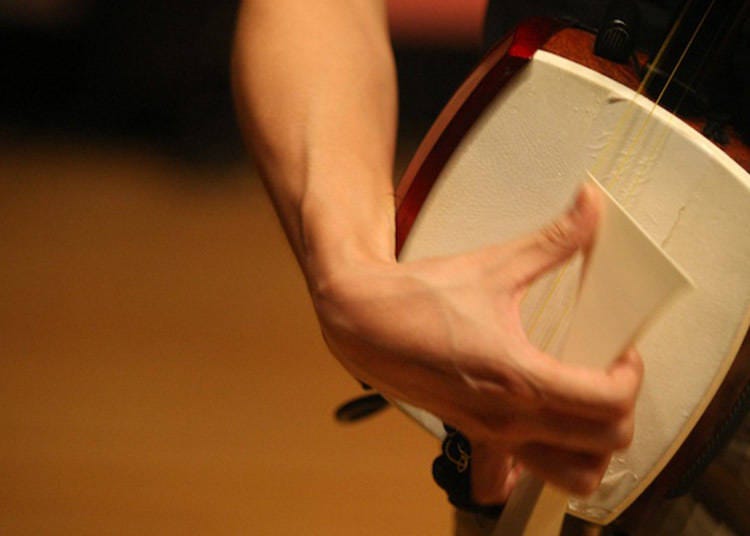
The shamisen is a three-string instrument played using a large plectrum called bachi. There are different kinds of shamisen. The one usually used in kabuki performances has a thin neck to facilitate the virtuosity required for that genre. The bridge (or neck) of the shamisen is usually a composite one and can be disassembled in three to five pieces. Similarly to a banjo or a guitar, the sound comes out of a resonating body. The strings are traditionally made of silk, but nowadays nylon ones are more commonly used.
That’s a lot to take in, but about instrumental music? When talking about Japanese traditional music we refer to any kind of musical performance not designed to accompany other performances, such as acting, dancing, or singing. Historically, performers who would play traditional music on its own, would use the same instruments and style that audiences could enjoy in kabuki plays and Gagaku performances. Although not easily framed within a particular genre, or as part of significant occasions, instrumental music contributed in the spreading of the tradition itself, making Japanese music become its own art, as opposed to being seen as a component of a larger performance.
Japanese traditional music has a long heritage and it’s still present and relevant in modern representations not only of its original form, but also as an adaptation to modern music (see below). Japan is famous for remaining attached to its tradition while constantly modernizing. Such culture can be seen in the various festivals and ceremonies related to religion, history, and traditional practices, but also in more mundane events like weddings, funerals, coming of age celebrations, and much more. The spirit of maintaining a connection with the past is very much alive in music as well, creating sounds and compositions that however modern, conjure a very distinctive melodic pattern, allowing tradition to stay alive, and modernization to run its course.
Enjoying a traditional Japanese music concert during your stay in Tokyo
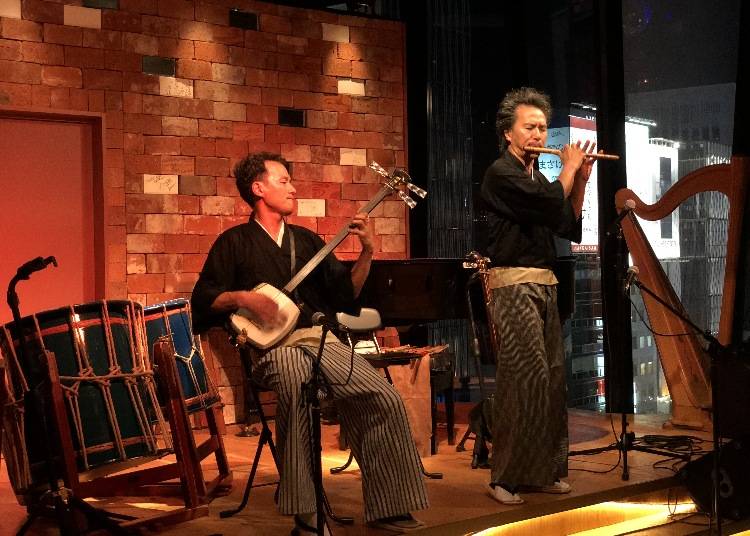
While the sights and tastes of Tokyo and beyond often top what visitors aim to experience during their stay in Japan, the chance to see a traditional cultural performance of some sort ranks closely behind – noh, kabuki, or even a concert.
Formed in 2008, the Aun J Classic Orchestra is a group of eight highly talented Japanese musicians that are masters of traditional instruments. This group has garnered a fair amount of popularity overseas, most recently being invited to play in Russia at a banquet attended by Russian President Putin, Japanese Prime Minister Abe, and French Prime Minister Macron. They currently collaborate with 12 other skilled traditional musicians to create “Team J.” With this group they have produced a series of superb concerts.
Originally held at Hands Expo Café in Ginza, the 45-minute mini concerts showcase a variety of captivating pieces, including original scores, traditional songs and even adaptations of Western songs to Japanese instrumentation. Live Japan caught up with two of the series’ core artists, twin brothers Ryohei and Kohei Inoue, who enjoy sharing the soul of Japanese music with audiences both in Japan and abroad. We learned more about their relationship with traditional music, the instruments, and what they hope to offer to the world through music.
Although very talented musicians now, the brothers came from relatively humble roots and had been more interested in rock and pop music than any other sound. That was, until the age of 18, when they had a chance encounter with taiko drums and shamisen. “I thought, ‘wow, these instruments are so cool. And the sound they make is so different. It was such an incredible moment [meeting these instruments] that we had no idea of before. We decided right then and there that we’d learn how to play them,” recalled Kohei. “So the instruments we perform with are shamisen [a 3-stringed instrument], taiko [drums] and fue [a bamboo flute]. Using these three instruments, we think about the kind of piece we can play. We could play only shamisen, but we think that a variety of instrumentation is a lot more interesting when doing a live performance.”
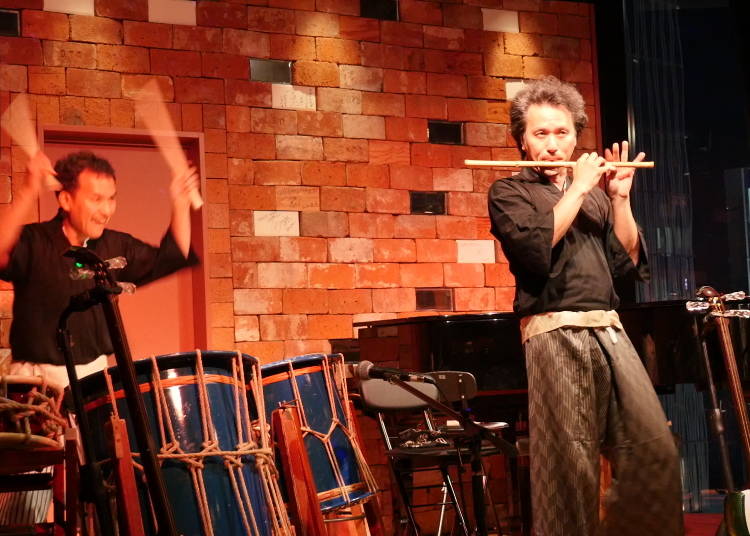
The instrumentation is a perfect arrangement indeed. But their style is less the sort of score you’d think of for a samurai film and more the kind that you’d want to swing dance to. It’s delightfully catchy. When foreign ears listen to the warm-throated twang of a shamisen accompanied with the chest-thumping beat of a taiko, there’s something so familiar and fun about the sound that it immediately lights a smile on your face as you tap your feet. When asked whether this is what he hopes people will take home with them, Kohei smiles. “I hope that people will become interested in the sound these Japanese instruments make.” Ryohei agrees. “I hope people will enjoy Japan better.” Nomatter whether you visit Tokyo, Kyoto or another of Japan’s charming cultural areas, music adds an additional context and dimension for sightseers to experience.
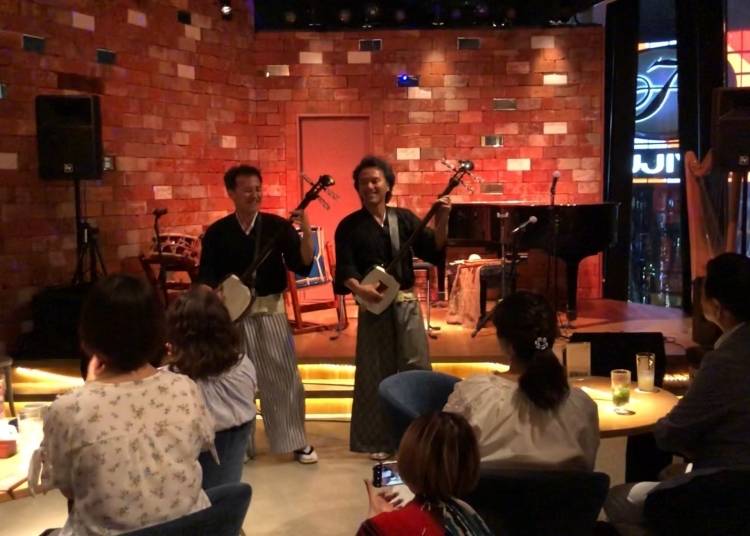
Looking around the sophisticated café/concert space, we saw that all the audience members had their eyes fixed on the stage. A gem in Tokyo’s posh east-side neighborhood of Ginza, Hands Expo Café seats about 60 and is exactly the kind of spot you’d drop by for a relaxing cappuccino during the daytime and a splash of something bubbly as the moon rises. When we visited, they offered a variety of hot and cold organic teas (¥700~), coffees (¥600~), smoothies (¥800~), and sparkling juice drinks, but also a solid selection of Japanese whiskies, craft rums, craft gins (starting at¥500 per glass) and more.

To tease your sweet tooth, they offer a refreshing variety of shaved ice with toppings like Kumamoto Purple Potato (¥900), Tokaichi Azuki and Uji Matcha (¥900), and even organic no-wax lemon (¥900). Plus their premium pancakes, like the popular ones smothered with syrup made from fresh Tochigi strawberries with a side of whipped cream (¥1300), are delightfully decadent. As a café dedicated to showcasing some of Japan’s unique cultural products, it’s a delight to have sweets to eat while you tap your feet.
Back to the music. When asked what they hope foreign visitors to take home with them from the experience, Ryohei smiled broadly as he gave his answer, saying simply, “I hope people will enjoy Japan better.” He noted that tourists come to visit not only Tokyo, but a variety of areas, and that music gives an additional dimension for sightseers to enjoy. “Feeling Japan’s charm and pleasantry [through music] – I hope people will bring that home with them.”
Simply put, the Inoue twins enjoy making music and hope that others will enjoy listening. “[Finding a place to listen to] traditional Japanese music is a little challenging,” continues Kohei. In order to appeal the charm of traditional Japanese music to others, they decided to help form the concert series. We know you’ll love it too!
Editor's Note: Since this article was originally published, the lineup of live concerts at Hands Expo Cafe has included a mix of traditional and contemporary styles. For more information, see https://www.hands-expo-cafe-ginza.com/ (in Japanese).
-
 TOKYU PLAZA GINZA東急プラザ銀座
TOKYU PLAZA GINZA東急プラザ銀座-
Address
Tokyu plaza Ginza, 5-2-1, Ginza, Chuo-ku, Tokyo, 104-0061
-
Nearest Station
Ginza Station (Tokyo Metro Ginza Line / Tokyo Metro Marunouchi Line / Tokyo Metro Hibiya Line)
1 minute on foot
- Phone Number 03-3571-0109
-
Address
Tokyu plaza Ginza, 5-2-1, Ginza, Chuo-ku, Tokyo, 104-0061
- Area
- Category
*Prices and options mentioned are subject to change.
*Unless stated otherwise, all prices include tax.
Popular Tours & Activitiess
Recommended places for you
-
Ad

A Tokyo Souvenir with Soul: The Handcrafted Leather of Bunkoya Oozeki
-

Where to Buy Electronics in Ikebukuro: 6 Tax-Free Shops for Tourists in Tokyo
by: Ran Tanaka
-

Akihabara Electronics: 7 Essential Stores in Tokyo for Tax-Free Deals & Unique Finds
by: Ran Tanaka
-

10 Shinjuku Hotels Balancing Cost Performance and Comfort: Perfect for Both Business and Tourism
by: Flurina YOC
-

Ueno Electronics Shopping Guide: Where to Buy Popular Gadgets – Top 6 Stores Near the Station with Tax-Free Deals
by: Ran Tanaka
-

'Unbelievable...!' 4 Weird Things About Japanese Bath Culture That Shocked Foreign Visitors!
Inspiration for Accommodations
-

Enjoy Mt. Fuji from the Comfort of Your Room! Recommended Ryokan with Mt. Fuji View
-

Stay Near the Cherry Blossoms! Hotels for Cherry Blossom Viewing in Tokyo
-

Family-Friendly Hotels with Free Shuttle to Disneyland: Convenient Access for a Magical Stay
-

Top Ranked Hakone Hotels with Mt. Fuji View: Enjoy Stunning Scenery from Your Private Space
-

Convenient Tokyo Hotels with Airport Shuttle: Ideal for Families and Heavy Luggage
-

Stunning Tokyo Tower View Hotels: Enjoy Spectacular Scenery from Your Private Space
-

Convenient Asakusa Hotels with Kitchens: Ideal for Extended Family Visits
-

Experience Luxury: Hakone's 10 Best Five-Star Accommodations
-

Enjoy Mt. Fuji Autumn Leaves! Top Hotels Near the Popular Autumn Leaves Corridor
-

Experience Hakone Fall Foliage from Your Room with Stunning Views
-

The Best of Japan: 11 Major Cities Every Traveler Should Visit
-

Secrets to Shopping in Japan: Guide to Annual Sales in Japan & Where to Shop
by: Miyu Shimada
-

Why Is This Even Possible?! Why Foreigners Are Shocked by Japan's Summer Festivals!
-

Tokyo Roppongi|Roppongi Station Area Map & Sightseeing Information
-

Tokyo Tsukiji|Tsukiji Area Map & Sightseeing Information
-

What to Pack for Japan: 8 Essential Things for a Hassle-Free Trip
- #best ramen tokyo
- #what to buy in ameyoko
- #what to bring to japan
- #new years in tokyo
- #best izakaya shinjuku
- #things to do tokyo
- #japanese nail trends
- #what to do in odaiba
- #onsen tattoo friendly tokyo
- #daiso
- #best sushi ginza
- #japanese convenience store snacks
- #best yakiniku shibuya
- #japanese fashion culture
- #best japanese soft drinks



















